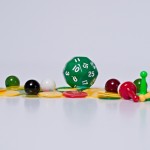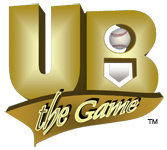UBTG SAMPLE PLAY-BY-PLAY
While the ULTIMATE BASEBALL THE GAME box includes a step-by-step order of play (both for basic and advanced play), we are providing the following sample play-by-play here on our site. Because UBTG plays so realistically, there are too many variables to cover definitively here, but this sample should give you a good feel for how the game plays.
 Each gamer (i.e., each team) drafts his/her roster and establishes a starting lineup (including a starting pitcher). Each gamer keeps a matching set of 4 marbles (consisting of 4 colors, representing different pitching variables such as location, speed, and type), along with some lettered tokens (representing such strategies as “playing in for the bunt”, “situational hitting”, and so on). On each pitch, these marbles and tokens are kept under the table out of view from the opposing gamer, allowing some degree of surprise.
Each gamer (i.e., each team) drafts his/her roster and establishes a starting lineup (including a starting pitcher). Each gamer keeps a matching set of 4 marbles (consisting of 4 colors, representing different pitching variables such as location, speed, and type), along with some lettered tokens (representing such strategies as “playing in for the bunt”, “situational hitting”, and so on). On each pitch, these marbles and tokens are kept under the table out of view from the opposing gamer, allowing some degree of surprise.
Now, let’s suppose Greg Maddux is the pitcher on the mound, and he is facing Ty Cobb (who is batting leadoff).
First, the pitcher:batter “differential” is established. Maddux’ pitching rating is “13”, while Cobb’s hitting rating is “14”, so Cobb is “up” one spot on Maddux on the “Pitcher:Batter Differential Table” (located on the game board). Additionally, however, Maddux is right-handed, while Cobb is lefthanded, so this adds one point in Cobb’s favor, putting him up two spots over Maddux. This means, among other things, that many dice-determined play results will be modified by two points in Cobb’s favor (so, for example, a die roll of 14—on the 30-sided die—would end up being modified to a 16, which would result in less damage to Cobb).
Maddux’ team now chooses from among its 4 marbles (pitch types). Maddux’ “best” pitches are “white” and “green”, so these pitches tend to produce more challenging situations for Cobb. Nevertheless, Maddux doesn’t want to overuse these pitches, as Cobb would be too likely to take advantage. The idea is to keep the batter guessing, and keep the batter guessing the pitch incorrectly. Additionally, Cobb (with his relatively high speed rating) is likely to play small ball and try to bunt. So Maddux’ team chooses the “white” marble, but also includes the “B” token with its pitch selection (i.e., plays in for the bunt, ready for small ball tactics).
Meanwhile, Cobb’s team indeed includes its “B” token (i.e., representing its intention to bunt), but decides to select the “green” marble.
These selections all are made “under the table”, out of the opposing team’s view. The selected marbles and tokens are placed in the gamers’ enclosed hands (still hidden from view), but the enclosed hands are now positioned above the table surface (to show that the selection process is now complete). Once each team is ready, each enclosed hand is opened and the hidden contents are revealed. So now each team knows that Maddux is throwing the “white” pitch and is playing in for the bunt, and Cobb has guessed the pitch incorrectly (“green” is not a match) and also is intending to bunt.
What Players Are Included In The Game Box?
Normally, the batting team must follow through with its intentions, but, because Cobb is attempting to bunt, he has the option to retract the bunt at the last second and “take” the pitch. Since his guess was incorrect (and since this mismatch would decrease the chances for a successful bunt), he decides to “take”. He declares his intention to “take”, rolls the die, and refers to the appropriate table on the game board (specifically, the Play Results Table Supplement, which is always used on a “take”). This roll results in a “strike”. So now the count is 0-1 and Maddux prepares to deliver the next pitch.
Let us assume that the second pitch is managed similarly to the first (i.e., the fielding team continues to play in for the bunt and Cobb tries again to lay down a bunt), but Cobb guesses incorrectly yet again, and decides to take again. This time the result is a “ball”, so the count now is 1-1, and the teams
prepare for the third pitch.
This time, the fielding team manages its pitch similarly (plays in for the bunt), but Cobb decides to turn the tables and swing away (i.e., he does NOT include the “B” token with his pitch-guess). He still guesses the pitch incorrectly, but this time makes contact (as per the appropriate table—the Play Results Table). True to form against a Maddux pitch (especially if guessed incorrectly), the contact is off just enough, resulting in a routine ground ball to 1B (note that without Cobb’s pitcher:batter advantage, the result could have been a popup…an even worse result). Nevertheless, because the fielding team was playing in for the bunt, there is a slight chance that this routine grounder will end up getting through for a hit. The batting team rolls the die again and refers to the appropriate table. The result is that the grounder indeed gets through the infield for a single. So now Cobb is on 1B.
[prima_products title=”FEATURED PRODUCTS” category=”featured-products” number=”6″ orderby=”rand” image_width=”230″ image_height=”180″ sale_icon=”yes” name=”alwaysshow” name_bg=”black” name_color=”white” slider=”3″ slider_auto=”yes”]
Now the teams proceed to the next pitcher:batter matchup. Maddux now gets ready to pitch to the 2-hole batter, who happens to be Joe Morgan (another lefty). Morgan’s hitting rating is “11”, however, so the pitcher:batter matchup ends up favoring Maddux by 1 point (the difference in ratings is 2, but Morgan gets a 1-point advantage for being left-handed against Maddux).
As Maddux gets ready to deliver the first pitch to Morgan, the situation is considerably different from when Cobb was at bat. Cobb, after all, is now on 1B, and is likely going to take a “risky” lead (a “normal” lead always is assumed in UBTG, but a risky lead means there is enough of a lead taken that play results—including steals, advances, pickoffs—could be affected). The pitching team must consider several factors:
1. Should we attempt to pick off Cobb (there is a slight chance the pickoff attempt might be wild, possibly resulting in a 2-base advance to 3B—because of Cobb’s high speed rating)? 2. Should we throw a slow or fast pitch (a fast pitch affords the fielding team a slight advantage when attempting to throw out a stealing runner)? Of course, the batting team might anticipate such a tactic and guess correctly. 3. Should we play in for the bunt (if Morgan surprise bunts and we are not ready, there is a good chance we will get no outs…whereas if we are ready, we have a much better chance of at least getting Morgan out at 1B)?
Note that if Gehrig were on base (instead of Cobb), the fielding team would have less to be concerned about, as Gehrig’s speed rating is only a “1” (not nearly the base-running threat that Cobb is).
Let us assume that Morgan (either on a bunt play or routine grounder) is thrown out at 1B and Cobb advances to 2B. Now there is 1 out, and Ruth comes to bat.
If this is the first inning, the at bat might proceed normally with little fanfare. It might end in an out, but, knowing Ruth, it might also end up as a 2-run dinger. Let us assume, however, that this is a late inning, and the score is close. Now the fielding team must consider the following options.
1. Do we intentionally walk Ruth? This avoids a big hit, and creates a better opportunity for a force play, but it puts another base runner on base. Furthermore, Gehrig is waiting on deck, so is it really wise to walk Ruth? 2. Do we pitch around Ruth? That is, we do not intentionally walk him, but we pitch to the edges of the plate (known in UBTG as pitching in the “ball mode”, which can be selected on any given pitch). If Ruth swings and makes contact in the “ball mode”, he is less likely to get a solid hit; if he takes, he is more likely to walk, with the outside chance we might end up catching him looking at a called strike. 3. Do we bring in a left-handed reliever who will match up slightly better against Ruth? 4. Do we play the lines to prevent an extra base hit?
Bear in mind that we have not covered every possible decision. There are hit-and-runs, tag-and-runs, situational hits (that sacrifice power for accuracy), and a whole host of additional strategies and tactics that are too numerous to mention here. But we believe this play-by-play sample gives you a feel for how UBTG plays… which, of course, we believe simulates real-life baseball with amazing accuracy!
Have a question or comment? Visit our forum!

Join Our Community!
Extended Opportunity: An Ultimate Web-Hosting Solution For Business Owners https://ext-opp.com/Ho…
Extended Opportunity: A.I Create & Sell Unlimited Audiobooks to 2.3 Million Users - https://e…
alyson: I’m here to seduce you [OC] http://prephe.ro/Phqn…
melva: Touch and lick my nipples http://prephe.ro/Bdsn…